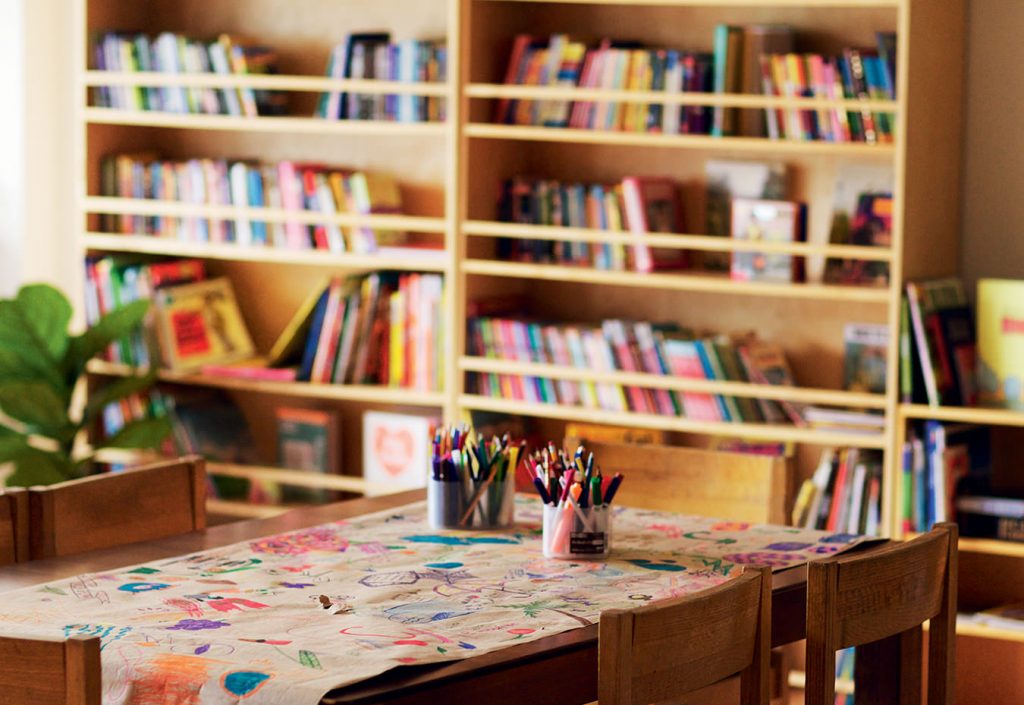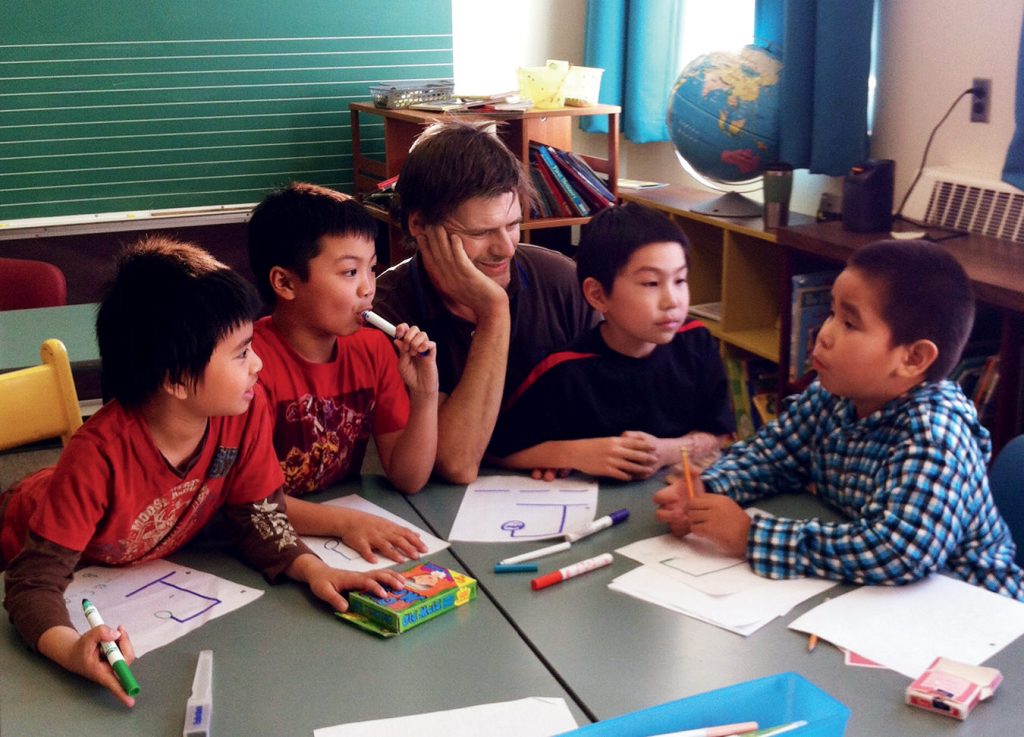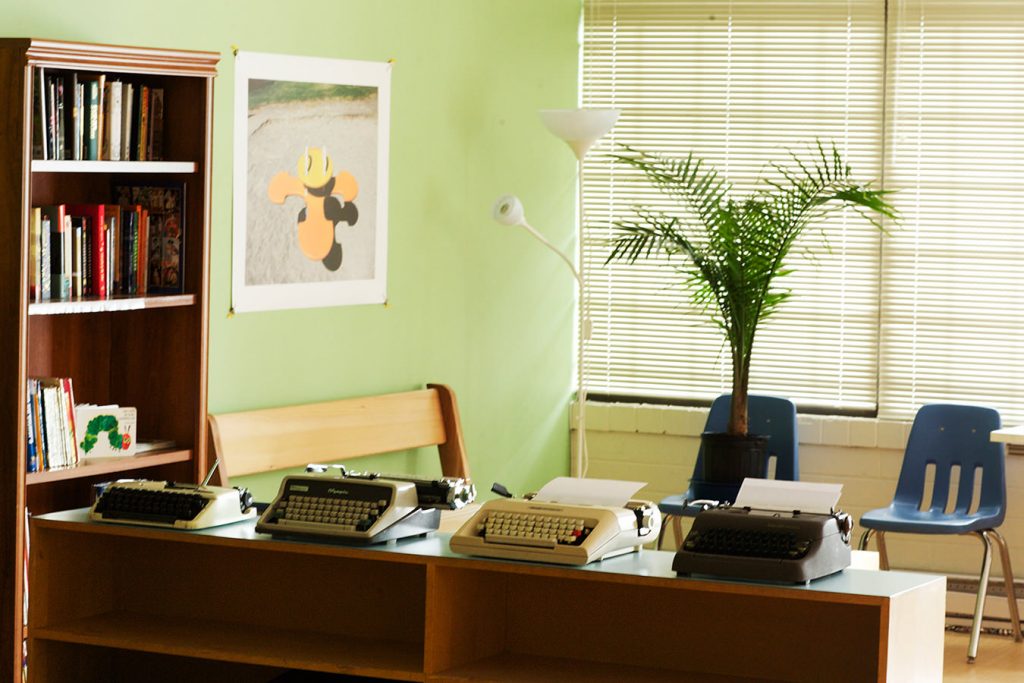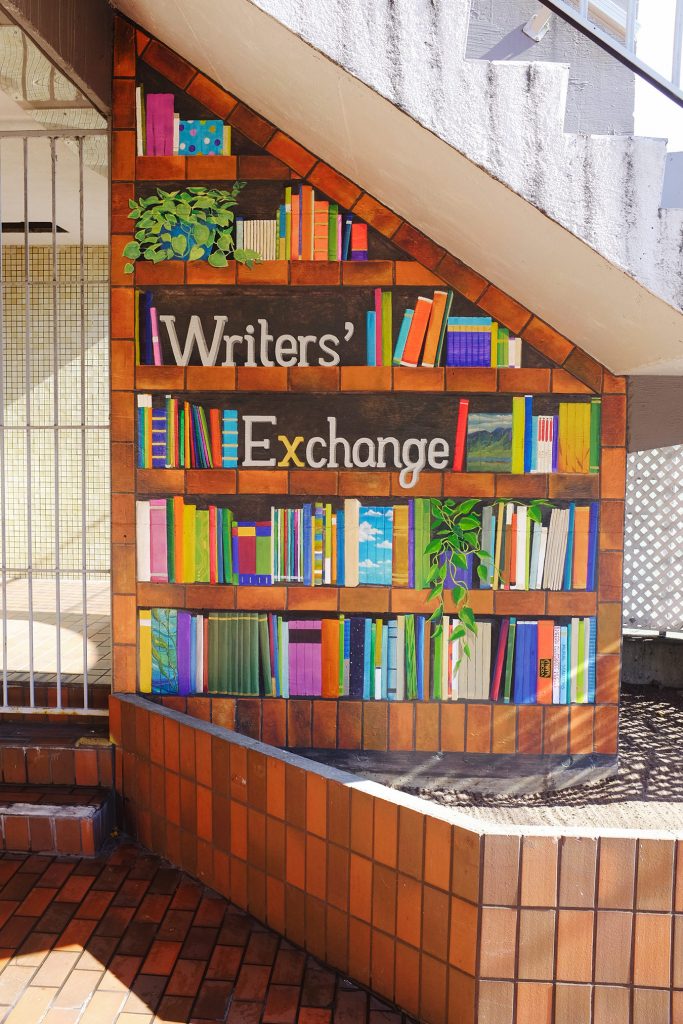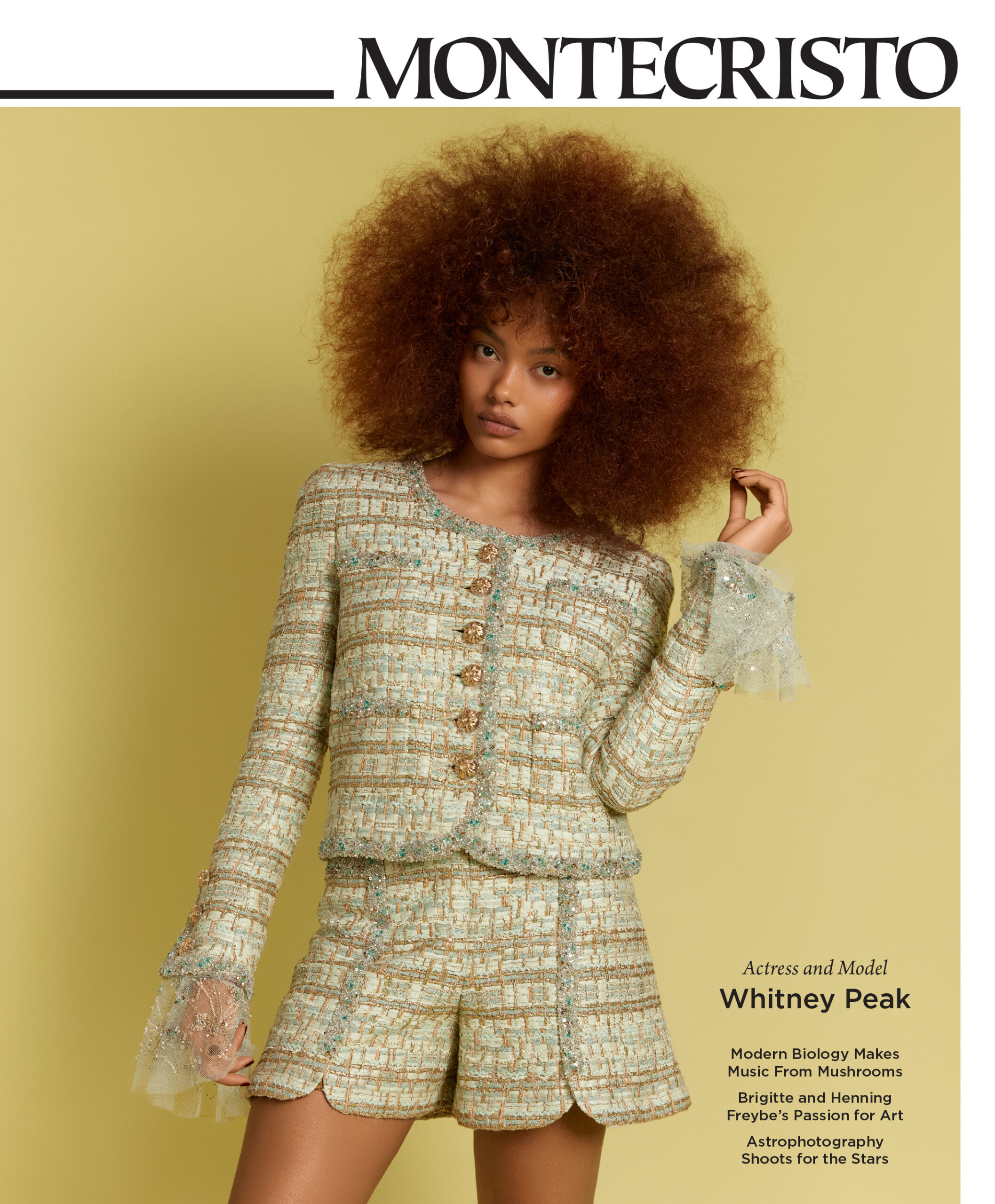In the summer of 2013, Lucas, aged 9, from Vancouver, took a photo depicting a stem of pink foxgloves stippled with freckles, framed against a blurry, green background. “Flowers are temporary things in temporary places,” he wrote. “Flowers really light up this world, and if we didn’t have flowers, our whole world would be dull because there would be no colours from the flowers. I can barely describe the flower because it is so beautiful in thousands of ways.” To which I am tempted to add, move over Shakespeare.
Flipping through the book containing Lucas’s picture and text, you will see images ranging from honeybees to water fountains, from a wall graphic of a fighting soldier to a narrow alleyway, all eloquent expressions of the lives Lucas and his schoolmates observe and record. Their work appears in chapbooks put together by the Writers’ Exchange, the brainchild of former editors Sarah Maitland and Jennifer MacLeod. In 2010, Maitland interned in San Francisco at 826 Valencia, started by writer Dave Eggers to enhance literacy among American school kids. Upon her return, Maitland ran literacy programs for kids in East Vancouver before opening the KidSafe Writers’ Room program in September 2011. An old classroom at Queen Alexandra Elementary was transformed into a safe space where kids could drop in after school to complete homework and creative writing projects with volunteers. In the summer of 2012, MacLeod came on board, and the program also became a project of Tides Canada Initiatives and was renamed the Writers’ Exchange. Now, over 200 Vancouver WE volunteers help our inner-city kids embrace words at their location at 881 East Hastings Street as well as through programs held at their home school.
From inception, the program was well received by all. “We actually had too many kids signed up for the program in the beginning and had to restrict them to attending only a couple times each week,” Maitland says. “They were really excited to have a free, fun place to go after school, and the fact that we provided volunteer mentors and literacy programming was just a bonus. Now they come because they love the volunteers and writing activities.”
“Kids have to be excited about what we are doing,” says MacLeod. She is standing in a light-filled room at the Writers’ Exchange, where she runs creative and engaging reading and writing projects for small groups of kids. For some programs, MacLeod picks the kids up from inner-city schools in the neighbourhood and walks the group to the Writers’ Exchange; this little yet meaningful act is affectionately called the “walking bus”.
“Some locations find the “Chicken Big” book hilarious, while other favourites include “Ripley’s Believe It or Not!” and “Guinness World Records”. They just love lots of pictures and weird facts.”
A range of very popular manual typewriters front the computers. Blown-up photos from some WE chapbooks decorate the walls. York House School donated the bookshelves, and Kidsbooks gave a $1,000 credit to stock them. The VPL Children and Teen librarians handpicked 200 books to be loaned each year to the Writers’ Exchange. MacLeod, together with her dad and two uncles, put in the flooring.
When the kids trek into the Writers’ Exchange, volunteers greet them, snacks are arranged on the tables, and everyone unwinds with Game Time. At every opportunity, words and their many permutations are incorporated into games such as hangman. This is reading by osmosis, since many of the children come from challenging home situations, are part of school breakfast programs, and may not have books at home. Here at the Writers’ Exchange, it is all about words and what fun reading can be.
“The kids fight over the Elephant and Piggie book series,” says MacLeod. Maitland adds, “Some locations find the Chicken Big book hilarious, while other 881 favourites include Ripley’s Believe It or Not! and Guinness World Records. They just love lots of pictures and weird facts.” And the kids are surrounded by their own work, too. A Different Eye: Neighbourhood Photography and Writing by the Kids of East Van, the publication containing Lucas’s story, is one slick production, designed on donated time by graphic artists, edited by Maitland, and printed at a huge discount by Hemlock Printers, who actually printed all of the other chapbooks at no cost to the Writers’ Exchange. B.Eastside, a high-school magazine, contains more weighty subjects including stories on bullying and even Hollywood’s latest mockery of mental illness.
And if, as British author Neil Gaiman claims, “our future depends on … reading and daydreaming … using our imaginations, and providing for others to use theirs” as an obligation for all citizens, then he might appreciate that Dan Post runs the WE Skate Club out of the Writers’ Room at Queen Alexandra Elementary on Tuesdays. Here, 12 kids write about skateboarding for the zine they are creating and then skate their hearts out in the playground using donated skateboards, helmets, and second-hand safety gear while Post teaches them better techniques and tricks. It is a civic duty indeed, and a perfect neuroscientific fit between dopamine and communication techniques.
“First graders are so much fun. They just want one person to be nice to them.”
Another Gaiman quote is also relevant: “Fiction has two uses. Firstly, it’s a gateway drug to reading. The drive to know what happens next, to want to turn the page, the need to keep going, even if it’s hard, because someone’s in trouble and you have to know how it’s all going to end … that’s a very real drive. And it forces you to learn new words, to think new thoughts, to keep going.”
I think of Gaiman’s words while sitting in as a guest at a Writers’ Exchange after-school program for kids in Grades 1 to 3 at Queen Alexandra Elementary F.A.M.I.L.Y (Fine Arts Multi-Cultural Integrated Learning for Youth) School. Photographer volunteer Joe Sales, father of three sons, sits at a table to which the boys gravitate. Volunteers Carina, Kelsie, and Haley are a magnet for the girls. When enough volunteers show up, each kid can have his or her own reading mentor. Kids trickle in and tuck into a carrot and dip snack. Some lads are restless, getting a spot of word exposure en route to their tae kwon do class. But casually and always smiling, Sales lassos even the most reluctant into games of hangman and playing cards and sharing their thoughts about a morning field trip to the Vancouver Art Gallery. It is great fun, and soon all the kids are involved. One of the smallest boys looks intently at a picture book while Sales reads it. Then, working the gap in his front teeth with concentration, the boy quietly takes the book to the other side of the round table to sound out the words slowly to himself.
Meanwhile, next door, volunteer Yvonne Hsiao is doing World-Building Wednesdays with students from Grades 4 to 7, using a nifty craft to channel the gift of words. Taking a piece of white paper, Hsiao invites them to use paper, scissors, glue, and colours to create a building on the top half of the paper, and then on the bottom half, to write about what they have built. Lips are licked and worlds imagined. A fountain of ideas, Hsiao has another craft up her sleeve: a character-creation sheet where children have put the name, home, age, profession, and drawing of their characters. For another Writers’ Exchange project, the kids studied and researched different careers; volunteer Sales took black-and-white portraits of 14 professionals, and students were invited to guess the careers of each person, liberating stereotypes and letting imaginations soar.
“First graders are so much fun,” says Sales, who volunteers here at least twice a week. “They just want one person to be nice to them.” With ample words of encouragement (“awesome, buddy—you are really good at this”) and many high-fives, half his work is done. When Albert Einstein was once asked how we could make our children more intelligent, his reply was both simple and wise. “If you want your children to be intelligent,” he said, “read them fairy tales. If you want them to be more intelligent, read them more fairy tales.” Einstein understood the value of reading and imagining and ultimately understanding.
Happily Ever After is a collection of illustrated fairy tales put together by seven WE volunteers with a class of students in Grades 1 and 2 at Mount Pleasant Elementary. “They then returned to school for the book launch, immediately opening the book to the table of contents to find their story and then their friends’,” says Maitland. “Quite a few brave, young authors got up to read their work into the microphone in front of their friends and families.” Should you flip through the lovely book of fairy tales that includes a prince named Dash, and rehabilitated sharks and wolves, you will indeed be transported.
Building photos: Joe Sales.
